#mardonius
Text
“The meal after the victorious battle of Plataea
According to Herodotus, the historian who described the Greek-Persian wars in detail, when the Spartan Commander-in-Chief Pausanias, after the victorious battle of Plataea, entered the scene of the killed Persian General Mardonius:
"... he ordered the bakers and the cooks to prepare the dinner Mardonius usually enjoyed. When Pausanias saw the luxurius daybeds, as well as the gold and silver tables loaded with the majestic dinner, he was surprised. As a joke, he ordered his own servants to prepare a Spartan dinner. The difference was so great that he laughed, called all the Generals of the Greeks and said to them, pointing to the two dinners: "Greeks, I called you here to show you the foolishness of the Median ruler who dines like this everyday and moved against us to steal our poverty."
We know today many nutritional details of the above scene, namely that the Greek General's meal did not stand out from the hoplites battling under his command. The ration was based on barley bulgur and unleavened barley bread, olives preserved in brine, onions and cured fish wrapped in fig leaves. In his haversack every soldier had salt and thyme to flavor the food, dried figs and a small spit perhaps, for the rare occasion that he would find meat. The army's logistics provided also goat cheese, fresh fruit (figs and grapes in the case of the Battle of Plataea, which took place in late August) and wine diluted with water to give courage to the fighters.
The Persians, who, in their vast and multinational troops, served Greeks, Indians and Ethiopians, were supplied by their Theban allies. They also ate barley bread, along with some goat meat, dried dates and almonds. However, the pyramidal structure of the Persian army required Mardonius and his high rank officers to enjoy roasted ducks and peacocks, pilaf flavored with cardamom, honey dripping sweets, wine made from dates and strong barley beer.”
Source: https://olyrafoods.com/blogs/wisdom-treats-blog/the-meal-after-the-victorious-battle-of-plataea
Olyra is the site of a Greek businessman who makes alimentary products inspired by the ancient Greek diet. The information he provides about the culinary habits of ancient Greeks and Persians when these peoples campaigned seems trustworthy.
I remind here that the question of the motivation of the Persian attempt to conquer Greece is a complex one in Herodotus. But the story reported here illustrates well the theme of the imperial hybris, i.e., of the desire of empires and elites which have already too much to acquire even more through further conquest and expansion.
I remind also that this report is not a simplistic illustration by Herodotus of some cliché of “Oriental decadence”, as Mardonius is portrayed in the Histories as aggressive and prideful, but also as competent and brave.
And of course the tragic irony of the same story is that Pausanias, the victor of Plataea and savior of the Greek freedom, the defender of the austere Greek way of life face to the Persian culinary luxury, not only adopted some time later the lavish lifestyle of the Persian nobility, but he was even accused of plotting with Xerxes for the subjugation of Greece and was put to death for this reason by the Spartans - through starvation...
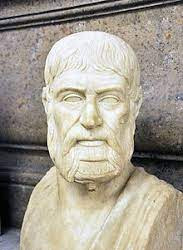
Bust of Pausanias, in the Capitoline Museums, Rome.
18 notes
·
View notes
Text
Ryu Number: Xerxes I
Xerxes I, also known as Xerxes the Great, was the ruler of the Achaemenid Empire from 486 BCE until his assassination in 465 BCE. At the time of his ascension to the throne, the Achaemenid Empire ran from the eastern end what's now Pakistan to the west end of what's now Turkey. You might notice that that's about the same amount of empire in about the same location as Alexander the Great had—that's because Alexander the Great was the guy who took over the Achaemenid Empire and made it not-so-Achaemenid anymore.
It was awful big, is what I'm saying.
But let's be honest: You probably know Xerxes I better as the Bad Guy with the nose ring in that one weird Spartan hagiography Gerald Butler was in. Fugging Miller.
Anyway, Xerxes I almost certainly has a Ryu Number of 2, and definitely not a Ryu Number more than 3, but there's some stuff.
The problem with finding a Ryu Number of Xerxes I is that 5th-century-BCE Persian monarchs don't show up in video games that often, for some reason. He makes a historical appearance in the Assassin's Creed Odyssey DLC Legacy of the First Blade...
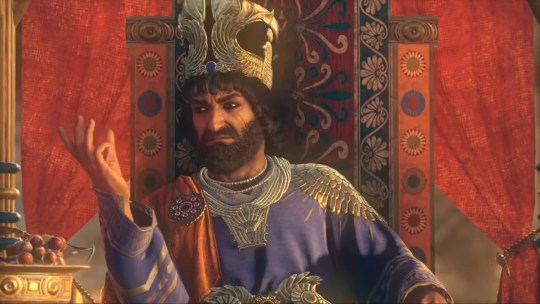
...but unfortunately, Odyssey takes place too far after the times of myth and legend for anyone big enough to be a Minecraft skin in Greek-mythology-inspired DLC to show up.
It doesn't help, either, that in Assassin's Creed lore, all the "gods" were just members of a Precursor Race pretending to be gods, a la Stargate. No, that's not "Hera," that's a jerk Precursor Person who's taken on the identity of "Hera," all the better to lead mankind around like a clowder of schmucks. She's pretending to be Norse elsewhere. Don't fall for it.
(There's also A Minotaur, which feels like it ought to connect via that Minecraft skin pack, but if I'm understanding the Odyssey lore correctly—and I very well might not be; holler at me—the minotaur the player encounters isn't actually the Minotaur from the myth we know and love, but some random other guy who subsequently got his hands on the Precursor Technology that turns you into a minotaur. Yeah, everything is Precursor People in Assassin's Creed. It's kind of disappointing.)
Of course, you can still get to Xerxes through Odyssey if you want to—a handful of historical characters who don't have Minecraft skins show up—but you'll need an extra step. And if we're going to have an extra step anyway, I'm going to go for the route that doesn't need Assassin's Creed, partially because I haven't played the games yet but mostly because I'm still really disappointed about the Precursor People thing.
Which means, unfortunately, it's back to Miller.
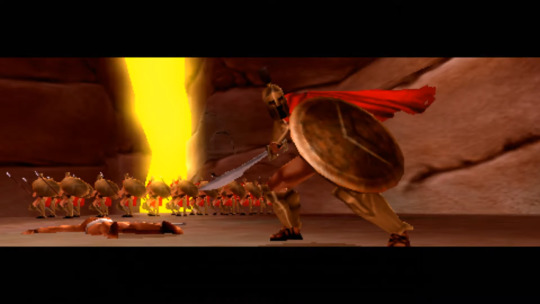
I'll say this: For all that 300: March to Glory is Not A Very Good Video Game, it left me the impression that someone behind the scenes actually did the bare minimum research into the Greco-Persian Wars. Persian commanders Hydarnes and Mardonius make appearances (if only to provide something unique to hit), and Mardonius even survives the movie-equivalent events of the game until an epilogic, post-movie level that takes place during the Battle of Plataea—which is, indeed, where the historical Mardonius bit it. It's not much, but I had to watch the whole dang thing, so I'll take what I can get. Gets me more names for The Chart, besides.
As for connecting this game to Ryu, you can, of course, count on the Ol' Dependable of Games With Historical Figures:

...Or maybe you're not a fan of Anime And Things That Look Like Anime, in which case, try this, instead:

I'm not sure I can explain how weird Spartan: Total Warrior is—by which I'm referring to its existence more than anything in the game itself, though the content's pretty weird, too. For context, Total War is a series of strategy games featuring a combination of turn-based strategy, resource management, and real-time tactical control (so sayeth Wikipedia). There are a coupla Warhammer entries in the franchise, sure, but the vast majority of the games focus on real, historical campaigns and factions.
Spartan: Total Warrior, on the other hand, is a hack-and-slash that took one look at a history book and immediately took a pair of shears to it. The story starts in 300 BCE: The Roman Empire, led by Emperor Tiberius, has conquered almost the whole of Greece, with only Sparta remaining, and Leonidas leads his men into battle to oppose him. Later, the Romans reveal a superweapon powered by the imprisoned Medusa. Sejanus, Tiberius' right-hand man, is a powerful necromancer who kills and resurrects Castor's brother Pollux. One mission involves protecting Archimedes, leader of the Athenian resistance, from assassination.
To quote someone on Discord, this is a game supposedly set circa 300 BCE that "has one side led by a king who died 200 years before, and the other by an emperor who reigned 300 years after (never mind the fact that Rome was still a senatorial republic)." If you forced a too-serious historian to play this game they'd end up on the floor in a frothing heap of rage and/or despair (actually, someone should totally do that; I want to see the Greco-Roman history version of Jonathan Ferguson having to analyze the firearms of Team Fortress 2).
Oh yeah and Beowulf is there.
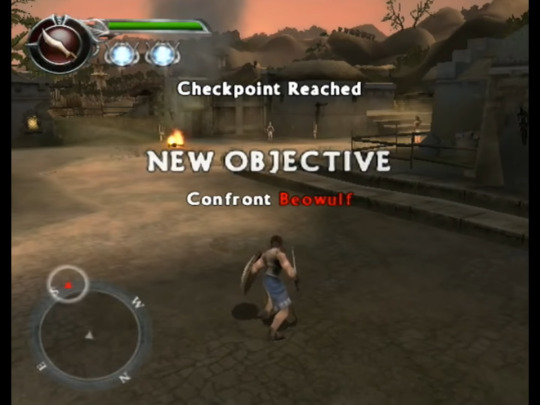
At some point you've got to appreciate—no, admire, even—the Xena:-Warrior-Princess-level decision to just Don't Worry About It.
And now that we have finished with the indisputable, let us proceed with the first of the hinky. Which is to say: Let's look at God of War: Chains of Olympus.
Chains of Olympus begins with an attack by the Persian navy on the Greek Attic peninsula (where Athens is, incidentally). The opening sequence features (among a whole lot of faceless Persian mooks) this prone-ish fella, who doesn't quite get to operating a ballista, irresponsibly leaving the work for Kratos instead.
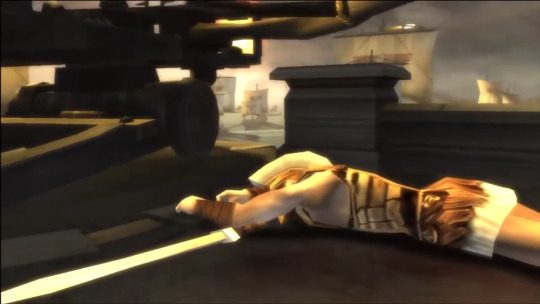
(Credit: Migeman)
Inspecting the body after all the local ruckus is over identifies him as "Eurybiades," the "leader of the Athenian army."
Eurybiades was—according to historical record—a real person, though God of War doesn't exactly nail it on the head. Herodotus (who historians depend on more due to him being one of a Very Small Number of sources rather than anything to do with actual reliability) names Eurybiades as a Spartan who, during the second Persian invasion of Greece, was given command of the Greek navy due to some political whatuppery (the Spartans said that if a Spartan didn't lead it they'd be Awfully Uncooperative).
Following this bit, Kratos confronts the King of Persia (identity unspecified), who is apparently personally leading the invasion himself, which seems dumb but was apparently the norm back in those days. I bet we'd have a lot less wars if we made our Presidents actually serve on the front lines whenever they started feeling belligerent.

(Credit: Ibid.)
Anyway, Kratos kills the King of Persia, because if the King of Persia killed Kratos the game would be a lot shorter. Now, there's no watertight confirmation that this is the second Persian invasion—the first one also featured attempted Persian inroads into Attica, and was recent enough that it's not inconceivable for Eurybiades to have shown up, there, too—but if this is the second Persian invasion, and that is the King of Persia that was King of Persia during the second Persian invasion, then that King of Persia is Xerxes I.
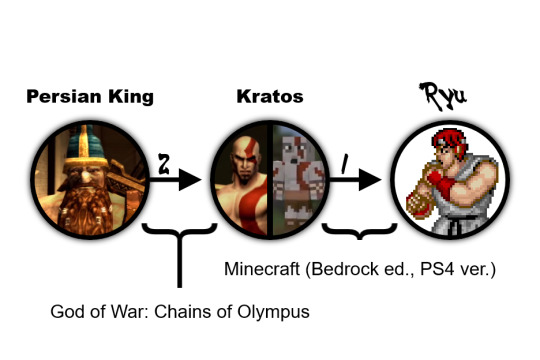

And now, I think, you peer up at me, gaze beseeching. "But KC," you say, anxious and afraid, "Xerxes I didn't die during his invasion of Greece! After Greek victory at the Battle of Salamis, Persian forces were forced to withdraw from Attica, including Xerxes I himself, after which he focused on lavish construction projects until he was assassinated fifteen years later for unrelated reasons! He didn't die in the Greco-Persian Wars at all!"
To which I say: You know who else didn't die in the Greco-Persian Wars? Eurybiades. And you know who definitely didn't die in a fit of paranoid, obsessive overwork in the heart of a monumental statue of Apollo on the isle of Delos?
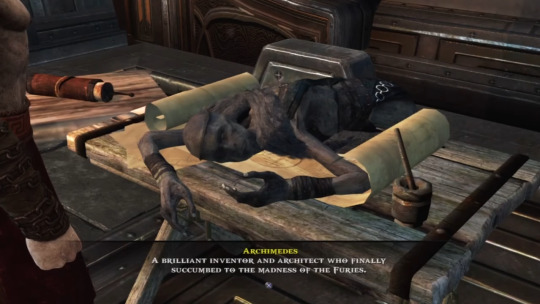
What I'm saying here is that God of War's relationship with historicality is fleeting at best, so maybe Don't Worry About It here, too.
(Incidentally, if it's the first Persian invasion of Greece that Kratos is mucking around in, then that king is actually Darius the Great, who also didn't die in Greece in real life. Darius is in Civilization V, though, so getting his Ryu Number is a lot easier.)

And speaking of Civilization, I've finally come to the shortest route I've found that, for all its likeliness, isn't as definite as I'd like, which is why I've saved it for last. You know how Civilization works, I think—you play a historical civilization (with a historical leader to match), and go up against other historical civilizations with their leaders. Like Darius, just now—he's your leader if you decide to play as the Persians.
Civilization III is like that...but unfortunately not as much like that as a fellow'd prefer. Sure, it's got its civilizations and leaders...

...But there's the occasional glaring unspecificity that's apparently there to make life difficult for me in particular. Yeah, sure, Montezuma here is most likely the second one—the one everyone knows, the one that had the real bad experience with Spain—but are you sure he isn't the first one instead? Like, absolutely sure? The instruction manual doesn't say, you know. How sure are you? Sure enough to bet a dollar? Two dollars? Fifty dollars? Your firstborn child? Why would I want your firstborn child, anyway? I don't want to look after a child; that's literally more work for me.
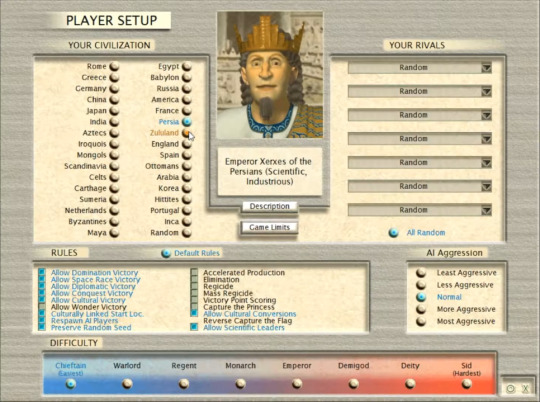
The Persian civilization exhibits the same problem here. Yeah, of course that's Xerxes I! If the team behind the game is picking out a historical figure named Xerxes to represent the Persians, it's got to be Xerxes I. But at the same time, there's technically nothing saying this isn't Xerxes II, a separate 5th-century-BCE Persian ruler of the Achaemenid Empire. I mean, it's terribly unlikely, seeing as Xerxes II ruled for 45 days before being killed by his half-brother, who ruled for six months before being killed by his half-brother, making him Not Exactly The Sort Of Individual You'd Put The Spotlight On, but Mahatma Gandhi and Joan of Arc are the leaders of Indian and French civilizations in this game, and that's weird, too. Gandhi was never the Prime Minister of India or anything like that, and Joan of Arc was a military leader, not a monarch.
Still, if you're willing to follow the reasonable assumption that the Xerxes here is Xerxes I, then the path that results is pretty dang optimal:


...If this is how you found out that Mahatma Gandhi is in Minecraft DLC, I'm sorry.
#ryu number#xerxes i#ryu#namco x capcom#minamoto no yoshitsune#fate/grand order#leonidas i#minecraft#minecraft (bedrock ed.)#ares#spartan: total warrior#minecraft (bedrock ed.#kratos#god of war: chains of olympus#street fighter x tekken#street fighter x tekken (PS3 ver.)#cole macgrath#playstation all-stars battle royale#mahatma gandhi#civilization iii: complete#super smash bros. ultimate#mario#mario's time machine#mario's time machine (SNES ver.)
78 notes
·
View notes
Text

September 22nd, 480 BC.
The Battle of Salamis
It was a naval battle fought between the alliance of Greek City-States under Themistocles of Athens & Eurybiades of Sparta, against the Persian Empire under Xerxes, in the Saronic Gulf.
After the betrayal of Ephialtes and the Greek defeat at the Battle of Thermopylae and subsequent retreat. The Greeks regrouped and under Athenian general Themistocles, were persuaded to bring the Persian fleet to battle once again.
The Persian Navy with a maximum estimated 1200 vessels, rowed into the Straits of Salamis. In the cramped conditions of the Straits, the great Persian numbers struggled to manoeuvre and became disorganised.
Seizing the opportunity, the Greek fleet numbering a maximum 378 vessels, scored a decisive victory. Xerxes retreated to Asia with much of his forces, leaving Mardonius one of his Generals, to complete the conquest of Greece.
However, the following year, the remainder of the Persian army was decisively beaten by the Greeks at the Battle of Plataea and at the Battle of Mykali.
The defeated Persians made no further attempts to conquer the Greek mainland.
304 notes
·
View notes
Text

More Saints of the Day January 24
St. Francis de Sales
Bl. Anicet Hryciuk
St. Artemius
St. Babylas
Bl. Bartlomiej Osypiuk
St. Bertrand
Bl. Daniel Karmasz
St. Exuperantius of Cingoli
St. Felician of Foligno
Bl. Filip Geryluk
St. Guasacht
Bl. Ignacy Franczuk
Bl. John Grove
St. Macedonius
St. Mardonius
St. Messalina
Bl. Michal Wawryszuk
Bl. Onufry Wasyluk
St. Thyrsus & Projectus
Bl. William Ireland
St. Zama
2 notes
·
View notes
Text
just a few quotes from ancient greeks that definitely seem to indicate that they considered the macedonians /not/ greek:
diodorus: “ From Europe, the Greek cities AND the Macedonians also sent embassies, as well as the Illyrians and most of those who dwell about the Adriatic Sea, the Thracian peoples and even those of their neighbors the Gauls, whose people became known then first in the Greek world.”
plutarch: “I by no means assent to Demaratus of Corinth, who said that those Greeks lost a great satisfaction that did not live to see Alexander sit on the throne of Darius. That sight should rather have drawn tears from them, when they considered that they have left the glory to Alexander and the Macedonians, whilst they spent all their own great commanders in playing them against each other in the fields of Leuctra, Coronea, Corinth, and Arcadia."
thucydides: “In all there were about three thousand Hellenic heavy infantry, accompanied by all the Macedonian cavalry with the Chalcidians, near one thousand strong, besides an immense crowd of barbarians.”
agelaus of naupactus (according to polybius): “Wherefore, I beseech you all to be on your guard against the danger of the crisis, and above all you, O King. You will do this, if you abandon the policy of weakening the Greeks, and thus rendering them an easy prey to the invader; and consult on the contrary for their good as you would for your own person, and have a care for all parts of Greece alike, as part and parcel of your own domains. If you act in this spirit, the Greeks will be your warm friends and faithful coadjutors in all your undertakings; while foreigners will be less ready to form designs against you, seeing with dismay the firm loyalty of the Greeks.”
thrasymachus: “Shall we become slaves to Archelaus, Greeks as we are, to a barbarian?”
herodotus tells us an account where both a macedonian and a spartan envoy ask the athenians for help (the macedonians asking them to side with the persians, the spartans asking them to reject the macedonians/persians) and after the macedonian made his case the spartan rebuttals with: "Do not let Alexander's smooth-sounding version of Mardonius' proposals seduce you; he does only what one might expect of him--a despot himself, of course he collaborates with a despot. But such conduct is not for you - at least, not if you are wise; for surely you know that in foreigners there is neither truth nor trust."
pausanias: “I have already said in my history of Attica that the defeat at Chaeronea was a disaster for all the Greeks"
now i don’t have anything against ancient macedonians. i am not only conveying what seems to me to be the sentiment ancient greeks had toward them.
personally, i find macedonians interesting. i think they were quasi-greek. they were within the greek sphere of influence. and they probably adopted a lot of greek culture. they definitely seemed to admire greek culture and their elites modelled themselves on them. and i’d probably even be willing to believe their elites were actually greek. it’s not that crazy to me to think that some greeks a long time ago colonized macedonia. but they also seemed to have become a bit colonized themselves. because while they shared a lot of culture with the greeks it seems they also had a number of cultural differences.
and i think macedonians are important in creating a unified greece and a panhellenic ideology and all that and that’s priceless. i honestly think there’s a lot of interesting things to say about that.
but still. to me it seems pretty clear the ancient greeks considered macedonians /non/-greeks.
but i’m open to evidence saying otherwise.
3 notes
·
View notes
Photo

HIPPODROME OBELISKS AND COLUMNS
The Hippodrome, or At Maidan (Horse-Square), is the large square immediately adjoining the Ah- medieh Mosque. It was originally laid out by Septimius Severus, in 203 A.D., but completed by Constantine the Great, who embellished it with monuments and statues. It was on the model of the Circus Maximus at Rome, and was an oblong enclosure some 1400 feet in length and about 400 feet wide, with four gates. It served as a race-course for chariot races, and also as an arena for wrestling matches and gladiatorial fights; and in it not only heretics and renegades, but even offending Patriarchs and emperors were burnt to death. Here also the emperors were proclaimed, and here the triumphal processions of victorious generals took place; in a word, the Hippodrome was the Forum of Constantinople. The entire area it covered was 535,866 square feet, while the surface occupied now by the At Maidan is 195,810 square feet.
The only monuments to be seen now on the Hippodrome are the three following:—
The Obelisk of Theodosius the Great, a monolith 61 feet in length and 6 feet square, of Egyptian syenite, which was originally erected in the Temple of the Sun at Heliopolis of Egypt, by Thotmes III., 1600 B.c., and was brought to Constantinople and erected by Theodosius the Great after his victory over Maximus (390 A.D.). It is in a good state of preservation, and bears a hieroglyphic inscription, the translation of which is as follows:—
Nursling of Toum
This powerful prince has conquered, the whole world and has extended his limits as far as the extremities of the great river Euphrates, which he has passed over and gained victories at the head of his soldiers. He is the nursling of Toum (Setting Sun) and rocked in the arms of the mother of the Gods. His royalty is as firm as that of Ra in the sky, and he has erected this monument in honour of his father Ammon, the master of the thrones of the Upper and Lower Egypt.
The Serpent Column, 18 feet 9 inches in height. It is composed of three bronze serpents erect on (;heir tails and twisted spirally round each other, the triple head was cut off by Muhammad II. with a single blow from his battle-axe, during his triumphal entry into the city after its capture by the Turks, and is now shown in the Imperial Museum. This column originally served as a stand for the golden tripod of the Pythia, the high priestess of Apollo, at the Oracle of Delphi, whence it was brought to Constantinople and erected in the Hippodrome by Constantine the Great. The inscription, now partly effaced, originally recorded in Greek characters the names of the thirty-one cities which combined at the battle of Platsea against the Persians under Mardonius and preserved Greece from the foreign yoke.
0 notes
Photo

HIPPODROME OBELISKS AND COLUMNS
The Hippodrome, or At Maidan (Horse-Square), is the large square immediately adjoining the Ah- medieh Mosque. It was originally laid out by Septimius Severus, in 203 A.D., but completed by Constantine the Great, who embellished it with monuments and statues. It was on the model of the Circus Maximus at Rome, and was an oblong enclosure some 1400 feet in length and about 400 feet wide, with four gates. It served as a race-course for chariot races, and also as an arena for wrestling matches and gladiatorial fights; and in it not only heretics and renegades, but even offending Patriarchs and emperors were burnt to death. Here also the emperors were proclaimed, and here the triumphal processions of victorious generals took place; in a word, the Hippodrome was the Forum of Constantinople. The entire area it covered was 535,866 square feet, while the surface occupied now by the At Maidan is 195,810 square feet.
The only monuments to be seen now on the Hippodrome are the three following:—
The Obelisk of Theodosius the Great, a monolith 61 feet in length and 6 feet square, of Egyptian syenite, which was originally erected in the Temple of the Sun at Heliopolis of Egypt, by Thotmes III., 1600 B.c., and was brought to Constantinople and erected by Theodosius the Great after his victory over Maximus (390 A.D.). It is in a good state of preservation, and bears a hieroglyphic inscription, the translation of which is as follows:—
Nursling of Toum
This powerful prince has conquered, the whole world and has extended his limits as far as the extremities of the great river Euphrates, which he has passed over and gained victories at the head of his soldiers. He is the nursling of Toum (Setting Sun) and rocked in the arms of the mother of the Gods. His royalty is as firm as that of Ra in the sky, and he has erected this monument in honour of his father Ammon, the master of the thrones of the Upper and Lower Egypt.
The Serpent Column, 18 feet 9 inches in height. It is composed of three bronze serpents erect on (;heir tails and twisted spirally round each other, the triple head was cut off by Muhammad II. with a single blow from his battle-axe, during his triumphal entry into the city after its capture by the Turks, and is now shown in the Imperial Museum. This column originally served as a stand for the golden tripod of the Pythia, the high priestess of Apollo, at the Oracle of Delphi, whence it was brought to Constantinople and erected in the Hippodrome by Constantine the Great. The inscription, now partly effaced, originally recorded in Greek characters the names of the thirty-one cities which combined at the battle of Platsea against the Persians under Mardonius and preserved Greece from the foreign yoke.
0 notes
Photo

HIPPODROME OBELISKS AND COLUMNS
The Hippodrome, or At Maidan (Horse-Square), is the large square immediately adjoining the Ah- medieh Mosque. It was originally laid out by Septimius Severus, in 203 A.D., but completed by Constantine the Great, who embellished it with monuments and statues. It was on the model of the Circus Maximus at Rome, and was an oblong enclosure some 1400 feet in length and about 400 feet wide, with four gates. It served as a race-course for chariot races, and also as an arena for wrestling matches and gladiatorial fights; and in it not only heretics and renegades, but even offending Patriarchs and emperors were burnt to death. Here also the emperors were proclaimed, and here the triumphal processions of victorious generals took place; in a word, the Hippodrome was the Forum of Constantinople. The entire area it covered was 535,866 square feet, while the surface occupied now by the At Maidan is 195,810 square feet.
The only monuments to be seen now on the Hippodrome are the three following:—
The Obelisk of Theodosius the Great, a monolith 61 feet in length and 6 feet square, of Egyptian syenite, which was originally erected in the Temple of the Sun at Heliopolis of Egypt, by Thotmes III., 1600 B.c., and was brought to Constantinople and erected by Theodosius the Great after his victory over Maximus (390 A.D.). It is in a good state of preservation, and bears a hieroglyphic inscription, the translation of which is as follows:—
Nursling of Toum
This powerful prince has conquered, the whole world and has extended his limits as far as the extremities of the great river Euphrates, which he has passed over and gained victories at the head of his soldiers. He is the nursling of Toum (Setting Sun) and rocked in the arms of the mother of the Gods. His royalty is as firm as that of Ra in the sky, and he has erected this monument in honour of his father Ammon, the master of the thrones of the Upper and Lower Egypt.
The Serpent Column, 18 feet 9 inches in height. It is composed of three bronze serpents erect on (;heir tails and twisted spirally round each other, the triple head was cut off by Muhammad II. with a single blow from his battle-axe, during his triumphal entry into the city after its capture by the Turks, and is now shown in the Imperial Museum. This column originally served as a stand for the golden tripod of the Pythia, the high priestess of Apollo, at the Oracle of Delphi, whence it was brought to Constantinople and erected in the Hippodrome by Constantine the Great. The inscription, now partly effaced, originally recorded in Greek characters the names of the thirty-one cities which combined at the battle of Platsea against the Persians under Mardonius and preserved Greece from the foreign yoke.
0 notes
Photo

HIPPODROME OBELISKS AND COLUMNS
The Hippodrome, or At Maidan (Horse-Square), is the large square immediately adjoining the Ah- medieh Mosque. It was originally laid out by Septimius Severus, in 203 A.D., but completed by Constantine the Great, who embellished it with monuments and statues. It was on the model of the Circus Maximus at Rome, and was an oblong enclosure some 1400 feet in length and about 400 feet wide, with four gates. It served as a race-course for chariot races, and also as an arena for wrestling matches and gladiatorial fights; and in it not only heretics and renegades, but even offending Patriarchs and emperors were burnt to death. Here also the emperors were proclaimed, and here the triumphal processions of victorious generals took place; in a word, the Hippodrome was the Forum of Constantinople. The entire area it covered was 535,866 square feet, while the surface occupied now by the At Maidan is 195,810 square feet.
The only monuments to be seen now on the Hippodrome are the three following:—
The Obelisk of Theodosius the Great, a monolith 61 feet in length and 6 feet square, of Egyptian syenite, which was originally erected in the Temple of the Sun at Heliopolis of Egypt, by Thotmes III., 1600 B.c., and was brought to Constantinople and erected by Theodosius the Great after his victory over Maximus (390 A.D.). It is in a good state of preservation, and bears a hieroglyphic inscription, the translation of which is as follows:—
Nursling of Toum
This powerful prince has conquered, the whole world and has extended his limits as far as the extremities of the great river Euphrates, which he has passed over and gained victories at the head of his soldiers. He is the nursling of Toum (Setting Sun) and rocked in the arms of the mother of the Gods. His royalty is as firm as that of Ra in the sky, and he has erected this monument in honour of his father Ammon, the master of the thrones of the Upper and Lower Egypt.
The Serpent Column, 18 feet 9 inches in height. It is composed of three bronze serpents erect on (;heir tails and twisted spirally round each other, the triple head was cut off by Muhammad II. with a single blow from his battle-axe, during his triumphal entry into the city after its capture by the Turks, and is now shown in the Imperial Museum. This column originally served as a stand for the golden tripod of the Pythia, the high priestess of Apollo, at the Oracle of Delphi, whence it was brought to Constantinople and erected in the Hippodrome by Constantine the Great. The inscription, now partly effaced, originally recorded in Greek characters the names of the thirty-one cities which combined at the battle of Platsea against the Persians under Mardonius and preserved Greece from the foreign yoke.
0 notes
Text
My rediscovered love for Greek history - part one
'By the late sixth century Persia was firmly established in Europe
(...)
He certainly did cross the Danube on
a bridge of boats
(...)
Herodotus seriously distorts the whole campaign, by representing it as essentially directed against the Scythians, and he makes Darius' motive the desire to revenge the Scythians for their incursion into Asia in the first half of the seventh century. That is interesting about Herodotus but it is not history. The real motive of Darius in extending his power into Europe, one divines, was simply to extend his power. The 'King in the great earth far and wide' was simply claiming his own, with suitable pomp. Armies in future years were to cross and recross the sea dividing Europe and Asia without the aid of a bridge. Mardonius' army returning from Plataea was not stranded in Europe in 479, although the bridges had been broken up, just as he was able to ship his land army across the Hellespont in 492.
But Darius, in a supreme gesture of folie de grandeur, had to have
a bridge, just as his successor had to. He would do nothing common
or mean. The advance into Europe would be led by the Great King in
person, just as the Emperor Claudius would do when Roman power
formally established itself in Britain'.
George Cawkell, The Greek Wars. The failure of Persia, OXford University Press, 2005, 47-49.
1 note
·
View note
Note
I’m the anon who asked for sick prof will, hope you have a good holiday! Hmmm will coming down with a nasty stomach bug and starts feeling lightheaded from not being able to keep food down while giving a lecture would be really cool to see
I live!
Will blinked once to bring the lecture hall back into focus, and then once more to clear the gray from the corners of his vision.
He swallowed thickly, forcing himself to carry on with his lecture. "By late 6th century BC, the Achaemenid Persian Empire ruled over what would now be the western coast of Turkey..."
The words sounded sloppy in his mouth, his tongue too heavy to articulate properly.
His water bottle sat untouched on the lectern, the condensation collecting on the outside slowly running down the sides and forming a puddle underneath.
He turned back to face the PowerPoint, intending to point his laser on the map to mark the location where General Mardonius' army crossed the Hellespont, but the simple act of turning his head left him reeling, and he had grab the edge of the lectern to keep from falling over.
Surely the class noticed his near stumble, but he was even more certain that Nico had seen it. His student-turned friend tended to watch him like a hawk, if not to take notes then to judge whether Will was preforming at his best.
And Will's attempt was subpar at best. He was well aware of his continued need to swallow down waves of nausea, as well as having to give himself brief moments to close his eyes, waiting for the spells of dizziness to pass.
He carried on as long as he could, droning on about Xerxes, and Thermopylae, and the Delian League until the words leaving his mouth stopped making sense in his ears.
"I need to sit down..." he groaned softly, not sure who could hear him.
He'd begun to sway somewhere around 480 BC, his tight grip on the lectern being the only thing keeping him standing. Now, if only his black peppered vision would let up enough so he could think of a way to combat the ever-growing nausea.
"Class dismissed," he announced finally, waiting until it was already near the end of his scheduled time. "Don't forget your essays are due tomorrow by 11:59pm."
There were murmurs from the crowd, but Will had already folded his arms and laid his head down on the lectern to see what all the fuss was about.
He heard the crowded hall begin to thin out, the din of students packing up belongings and chatting with one another drowning out the sounds of Will's obviously upset tummy.
"Are you hungover?"
Will sighed, knowing he should have expected Nico to appear at his side. And he supposed his friend's question was a valid one.
"I don't drink."
"Then you're sick."
"Please just leave me alone," Will groaned, all but begging. It'd been a long morning already, and Will just wanted to go home.
"Not a chance." He tugged at Will's arm. "C'mon, Solace, let's go sit down."
Will relented, lifting his head, but only because sitting was far more appealing than standing. However, moving was not going to be such a simple task anymore.
His head swam, his vision was hazy, and before he realized what had happened, he was on the floor staring up at the ceiling.
"Oh my gods, Will!"
Will blinked up at Nico, who had somehow gotten on the floor with him. He was cradling Will's head in his hands.
"What happened?"
"You just collapsed!"
This was probably the least composed Will had ever seen him, and if he'd been in his right mind to think so, he might have found this far less stoic Nico a touch endearing.
Instead, he closed his eyes, taking a deep breath in through his nose. "I don't feel so good..."
"What's wrong?" Nico asked, and Will felt a cool hand rest against his forehead. There was a pause, as though Nico was considering something. "How long have you been sick?"
Will thought, trying to gather his jumbled thoughts. "Last night," he answered finally, though it might have just been this morning. It was hard to tell. "Can you help me up? Think I'm gonna be sick..."
Nico whispered an affirmative, deliberately pulling Will into a seated position on the floor. The change in position, while slow, was not kind to him, leaving Will clamping his hand over his mouth, muffling a burp behind his fingers.
"Don't hold it in," Nico said, pulling a trash can in front of him. "You'll only feel worse."
Will shook his head, leaning forward over the bin. Saliva hung in tendrils around his lip, forcing him to remove his hand. "I can't—I don't want—no more..." he managed through small abortive heaves.
He lifted the small trash can beneath his chin, retching forcefully into the plastic. His whole body shook, his shoulders hiking up to his ears, his pale face reddening with the effort.
The lack of substance wasn't surprising to Will—he'd emptied his stomach long before class started. He let out a long nauseated belch, too miserable to be embarrassed now.
"It looks like you're empty," Nico said, sounding perplexed.
Will nodded, wiping his mouth before setting down the bin. "I haven't kept anything down for hours."
Shock crossed over Nico's face, then a hint of something that Will could only guess was anger, or exasperation. "Then why are you here?"
Will was confused by the question. "What do you mean?" He leaned over and spit into the trash can.
Nico rolled his eyes. "You're obviously sick, Will. Why didn't you just stay home?"
"It was too late," he said by way of explanation. The last time he'd thrown up was about 6:40 that morning, and his first class started at 8.
He closed his eyes again, dizzy and exhausted. He opened them only because he thought he heard Nico leaving.
Nico came back with Will's laptop. It had been on the desk near the lectern.
"I'm emailing the rest of your classes," he said, already beginning to type. "You're done teaching for the day."
Will wasn't going to argue. Right now the only thing he wanted to do was lie down.
"What about you?"
"I'm going to email my professors too. Clearly you'll die without anyone looking after you."
That earned Nico a ghost of a smile. "Thank you. You're my hero."
If a faint blush appeared on Nico's cheeks at Will's sentiment, they both chose to ignore it.
#illness#emetophilia#will solace#nico di angelo#solangelo#percy jackson and the olympians#heroes of olympus#my fiction#request#college au
86 notes
·
View notes
Text
Aftermath: Battle of Plataea (Out of Herodotus)
by A.E. Stallings
The Generals
After the blood-brimmed field, we were amazed to stride into those empty
silken tents – bright tapestries, wrought silver ornaments, the furnishings of
solid gold. Eyes glazed at all the untold booty: gods be praised! Our king bid
foreign cooks spare no expense to make the meal our foes would eat, prepare
their pastries, spices, wine. Such slowly-braised flesh melting off the bone!
Such colours, scents! Our king laughed as he laid out on the cloth, beside the
feast, our ration of black broth: “Behold! They came to rob us of our fare!” We
also laughed, though fed up with that food, the soldier’s mess, the black broth
of blood.
The Concubines
We heard the Greeks had won. At once I went and decked myself with every
bracelet, ring, gold necklace that I owned, and rouged my cheeks, and hastily
had my maids arrange my hair. The other concubines slumped in despair; but
I’d been snatched from Kos; my people, Greeks! Dressed in white robes of silk,
we fled the tent, and drove through corpses, far as the eye could see, until I saw
Pausanias, the king. I stepped with golden sandals through the gore, the lady
that I was, and not the whore, and knelt, a supplicant, Please set me free. The
roar of blood like silence in my ear, until: Lady, arise, be of good cheer.”
Lampon the Aeginite
“Your glory after this victory is sealed,” I told Pausanias to please him,
“Now crown it with revenge for Leonidas beheaded at Thermopylae. Remember the
restitution that Xerxes denied us, and how he said Mardonius would pay it?
Well, here is the cadaver – you just say it – and we’ll impale Mardonius’s head.”
He stood in silence as his face went sombre. “Stranger,” he addressed me, “On
this field the crime was well avenged.” As for that corpse, who knows what
happened to it? There are versions – the truth is not so straight it never warps.
Someone interred it – so I’ve heard it said – and reaped a handsome bounty
from the Persians.
Source: http://poetrysociety.org.uk/poems/from-aftermath-battle-of-plataea-out-of-herodotus/ .
Alicia Elsbeth Stallings (born July 2, 1968) is an American New Formalist and Philhellene poet and translator. She currently resides in Athens, Greece. Her latest collection, Olives was published in 2012, and her poem 'The Last Carousel, Aftermath: Battle of Plataea (Out of Herodotus)' appeared in the summer 2013 issue of The Poetry Review.
1 note
·
View note
Text
Chủ đề của bài La Paloma bắt nguồn từ cuộc xâm lược xứ Hy Lạp của vua Darius I nước Ba Tư vào năm 492 trước Công nguyên, thời điểm mà chim bồ câu chưa được biết đến ở châu Âu.
Lúc đó, hạm đội Ba Tư do đại tướng Mardonius chỉ huy đã gặp phải một trận bão ngoài khơi đỉnh Athos, nhiều thuyền chiến Ba Tư đã bị đắm trong trận bão này. Người Hy Lạp đã nhìn thấy nhiều chú chim bồ câu bay ra khỏi các xác tàu Ba Tư bị đắm và cho rằng những chú chim này mang về đất liền những thông điệp tình yêu cuối cùng của những thủy thủ đã bỏ mình giữa biển cả.
La Paloma, Wikipedia
21 notes
·
View notes
Text
Saints&Reading: Thu., Sept., 16, 2021
September 3_September16
SAINT PHOEBE THE DEACONESS (1st. c.)

St. Phoebe is recognized as the first woman deacon, although we know little about her life. She is honored as being the prototype for female deacons just as St. Stephen is the prototype for male deacons. In her book Women Deacons in the Orthodox Church [See book review in this issue.], Dr. Kyriaki FitzGerald suggests that St. Phoebe is an example of faith and service for female deacons.
St. Phoebe came from a very busy port area called Cenchreae, a popular stop for people traveling from Syria or Asia Minor. Although there has been a great amount of debate concerning what her actual duties as a deacon might have been, it is clear that St. Paul gave recognition to St. Phoebe, thanking her in public for her hospitality and for meeting the needs of the people in Cenchreae, and urging others to help her with her ministry as “a deaconess of the Church at Cenchreae.”
Centuries later, St. John Chrysostom praised St. Phoebe’s work for the Church as an inspiration and model for both men and women to imitate. He calls her a saint – a holy person and a woman who served the Church through the office of deacon.
Women were indeed called to serve in the early Church, as is seen in the example of St. Phoebe. It was an honor to be able to give such service to the community through charitable acts and dedication to the church community. There are many women in addition to St. Phoebe who are recognized by the Church for their various ministries – St. Poplia (fourth century), St. Sophia, known as the “second Phoebe” (fifth century), St. Tabitha, mentioned in the early Acts of the Apostles, also known for her almsgiving, St. Mary, St. Mark’s mother who opened her house for Christian meetings in Jerusalem, St. Lydia, who showed her hospitality to St. Paul and his companions, and St. Priscilla, who was involved in missionary work (FitzGerald 1998). Female deacons are mentioned in the salutations of the epistle to the Philippians (1:1), and the first epistle to Timothy (3:8,12).
Since the beginning of the Church, women have been using their talents and gifts from God to serve. I hope and pray that the Church will find some way to embrace these talents and gifts and restore the office of the female diaconate.
Source: St Phoebe Center for the Deaconness
THE PRIESTMARTYR ANTHYMOS, BISHOP OF NICOMEDIA, AND THE MARTYRS WITH HIM (302)
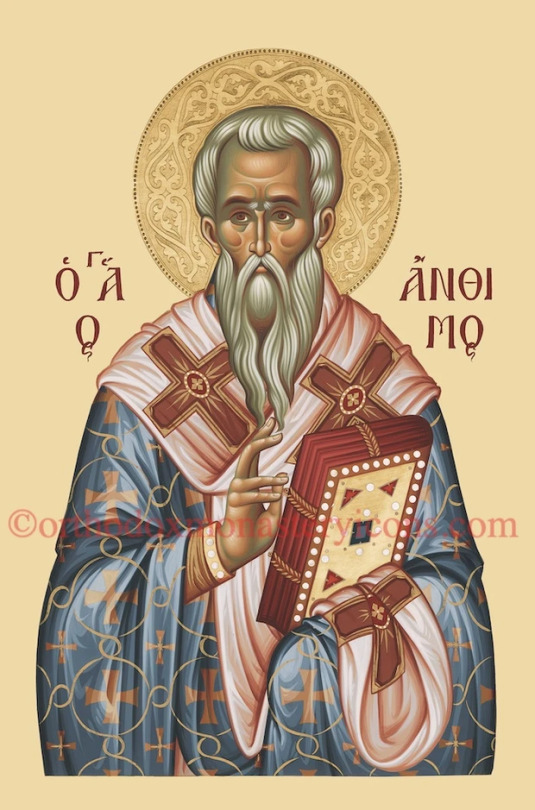
The Hieromartyr Anthimus, Bishop of Nicomedia, and those with him suffered during the persecution against Christians under the emperors Diocletian (284-305) and Maximian (305-311). The persecution became particularly intense after a fire at the imperial court at Nicomedia. The pagans accused the Christians of setting the fire and reacted against them with terrible ferocity.
In Nicomedia alone, on the day of the Nativity of Christ, as many as twenty thousand Christians were burned inside a church. However, this monstrous inhumanity did not frighten the Christians, who firmly confessed their faith and endured martyrdom for Christ.
Saints Dorotheus, Mardonius, Migdonius, Peter, Indes and Gorgonius died during this period. One of them was beheaded by the sword, others perished by burning, or being buried alive, or by drowning in the sea. The soldier Zeno boldly denounced the emperor Maximian, for which he was stoned, and then beheaded.
Then the holy Virgin Martyr Domna, a former pagan priestess, perished at the hands of the pagans, and also Saint Euthymius, because of their concern that the bodies of the holy martyrs should be buried. Bishop Anthimus, who headed the Church of Nicomedia, hid himself in a village not far from Nicomedia at the request of his flock. From there he sent letters to the Christians, urging them to cleave firmly to the holy Faith and not to fear tortures.
One of his letters, sent with Deacon Theophilus, was intercepted and given to the emperor Maximian. Theophilus was interrogated and died under torture, without revealing to his torturers the whereabouts of Bishop Anthimus. After a while Maximian managed to learn where Saint Anthimus was, and sent a detachment of soldiers after him.
The bishop met them along the way, but the soldiers did not recognize the saint. He invited them to join him and provided a meal, after which he revealed that he was the one they sought. The soldiers did not know what to do. They wanted to leave him and tell the emperor that they had not found him. Bishop Anthimus was not one to tolerate a lie, and so he would not consent to this.
The soldiers came to believe in Christ and received holy Baptism. The saint ordered them to carry out the emperor’s instructions. When Bishop Anthimus was brought before the emperor, the emperor ordered that the instruments of execution be brought out and placed before him. “Do you think, emperor, to frighten me with these tools of execution?” asked the saint. “No indeed, you cannot frighten one who wishes to die for Christ! Execution is frightening only for the cowardly, for whom the present life is most precious.” The emperor then directed that the saint be fiercely tortured and beheaded by the sword.
Bishop Anthimus joyfully glorified God with his last breath, and received the crown of martyrdom. (See December 28 for another account of the Nicomedian martyrs.)


JOHN 10:9-16
9 I am the door. If anyone enters by Me, he will be saved, and will go in and out and find pasture.10 The thief does not come except to steal, and to kill, and to destroy. I have come that they may have life, and that they may have it more abundantly. 11 I am the good shepherd. The good shepherd gives His life for the sheep. 12 But a hireling, he who is not the shepherd, one who does not own the sheep, sees the wolf coming and leaves the sheep and flees; and the wolf catches the sheep and scatters them. 13 The hireling flees because he is a hireling and does not care about the sheep. 14 I am the good shepherd; and I know My sheep, and am known by My own. 15 As the Father knows Me, even so I know the Father; and I lay down My life for the sheep. 16 And other sheep I have which are not of this fold; them also I must bring, and they will hear My voice; and there will be one flock and one shepherd.
HEBREWS 13:7-16
7Remember those who rule over you, who have spoken the word of God to you, whose faith follow, considering the outcome of their conduct. 8 Jesus Christ is the same yesterday, today, and forever. 9 Do not be carried about with various and strange doctrines. For it is good that the heart be established by grace, not with foods which have not profited those who have been occupied with them. 10 We have an altar from which those who serve the tabernacle have no right to eat. 11 For the bodies of those animals, whose blood is brought into the sanctuary by the high priest for sin, are burned outside the camp. 12 Therefore Jesus also, that He might sanctify the people with His own blood, suffered outside the gate. 13 Therefore let us go forth to Him, outside the camp, bearing His reproach. 14 For here we have no continuing city, but we seek the one to come. 15 Therefore by Him let us continually offer the sacrifice of praise to God, that is, the fruit of our lips, giving thanks to His name. 16 But do not forget to do good and to share, for with such sacrifices God is well pleased.
2 notes
·
View notes
Photo
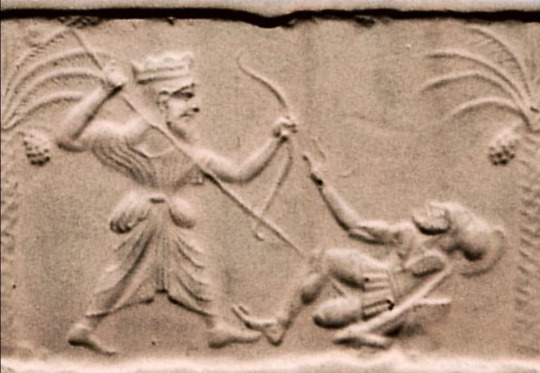
An Achaemenid king defeats a Greek hoplite.
Date: circa 490-470 BC.
Credit: Metropolitan Museum of Art.
The second Persian invasion of Greece may have ended with the battle of Platea in 479 BC, but by no means did the Persians view it as a total failure, and they even succeeded in what could have been their primary war goal.
When Darius I had invaded Greece in 490 BC, it was to punish the cities of Athens and Eretria for their involvement in supporting the Ionian Revolt. Although his army had successfully burnt Eretria to the ground, it was defeated at Marathon by the Athenians before it could reach Athens.
On the other hand, Xerxes’ invasion was presented by Herodotus as one of conquest, not a retaliatory action. There is however no indication in any Persian sources of this goal. Perhaps then Xerxes’ goals were no different to his father’s?
Having defeated the Greek coalition at Thermopylae, the Persian army made its way south, receiving submission from various cities before destroying Athens and looting the religious idols atop the Acropolis, which were distributed throughout imperial capitals across the Persian empire. In near-eastern cultures, such as in Neo-Assyria and Babylonia, robbing an enemy people of their religious idols often touted as a symbol of victory. Upon his return to Persia, Xerxes would have appeared in triumph, carrying with him the spoils of war, and the news of Athens’ destruction was wildly celebrated in Susa.
After the battle of Salamis, Xerxes left his cousin Mardonius in Greece in command of a picked body of troops. This could well have been due to fear at being stranded in Europe with the destruction of most of his navy, but it is equally possible that Xerxes’ considered his primary objective accomplished, which would explain why he took the majority of his army with him. With proclamations of victory spread throughout the empire, along with a wide assortment of booty being dedicated at imperial capitals, not only did a great many Persians likely believe that the expedition had been victorious, but Xerxes himself may have considered the war a success too, even in light of the later defeats suffered. At the very least, presenting Xerxes’ invasion of Greece as nothing but a failure for Persia is misguided, and neglects a more nuanced reading of our source material.
#ancient persia#ancient iran#persia#history#ancient history#ancient greece#athens#sparta#xerxes#darius#war
28 notes
·
View notes
Note
Were there any noteworthy horses during that time?
Red Hare was real. But do you know how such a unique horse ended up in Han China in the first place? Back in ye old days of Han, your favourite emperor Wudi sent a bunch of formerly nefarious soldiers to attack a bunch of Greek-ruled states in order to steal a bunch of heavenly horses. 3,000 of these horses were successfully stolen to be bred by the armies, and Wudi was very pleased when he saw them, claiming they were worth the many casualties.
They were described to look like "bronze", or " gold coins", and described to "sweat blood" when it exerted effort. Herodotus says they were "of unusual size". Red Hare was likely of this variety of horse.

They also came in a variety of other unique colours, such as pure white, as well as common ones. They were greatly sought after. Cyrus the Great drained a whole river after his own heavenly horse drowned in it. The Persian general Mardonius had a white one, and it was so feared by the Athenians that when Mardonius was killed in battle, his horse had been the primary target.
8 notes
·
View notes